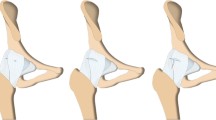Abstract
Purpose
We present a minimally invasive tissue-sparing posterior superior (TSPS) approach that intends to protect the abductor muscles during total hip arthroplasty, prevents the release of the short rotator muscles, and provides the surgeon with the option to repair the posterior capsule. We hypothesized that the TSPS technique would produce a better clinical outcome, faster recovery, and lower complication rates, and that it would not jeopardize acetabular component position.
Methods
A retrospective, observational study was conducted in a consecutive series of patients. A cohort of 130 patients (130 hips) operated with a standard posterolateral approach were compared with a cohort of 132 patients (132 hips) operated with a TSPS approach. Patients were assessed with the Harris hip score (HHS) and Western Ontario and McMaster Universities index (WOMAC), which were carried out preoperatively, one month (HHS only), three months, one year, and at four years post-operatively.
Results
Compared with the standard group, patients in the TSPS group showed a faster return to ambulation as reflected in better post-operative HHS and WOMAC scores up until one year (p < 0.05). No significant differences in HHS (p = 0.564) and WOMAC (p = 0.796) scores were found at the four-year follow-up. No major adverse events were observed in either group.
Conclusion
The TSPS approach yielded better early clinical outcomes and appears to be a safe and reliable technique. However, these early differences do not appear to be sustained over time, as comparable mid-term clinical outcomes with similar complications rates were observed.









Similar content being viewed by others
References
De Geest T, Fennema P, Lenaerts G, De Loore G (2015) Adverse effects associated with the direct anterior approach for total hip arthroplasty: a Bayesian meta-analysis. Arch Orthop Trauma Surg 135:1183–1192. https://doi.org/10.1007/s00402-015-2258-y
Penenberg BL, Campbell J, Woehnl A (2015) The mini anterior approach: optimizes total hip arthroplasty outcomes—opposes. Semin Arthoplasty 26:140–145
Macheras GA, Christofilopoulos P, Lepetsos P, Leonidou AO, Anastasopoulos PP, Galanakos SP (2016) Nerve injuries in total hip arthroplasty with a mini invasive anterior approach. Hip Int 26:338–343. https://doi.org/10.5301/hipint.5000352
Woolson ST, Pouliot MA, Huddleston JI (2009) Primary total hip arthroplasty using an anterior approach and a fracture table: short-term results from a community hospital. J Arthroplast 24:999–1005. https://doi.org/10.1016/j.arth.2009.04.001
Murphy SB, Ecker TM, Tannast M (2006) THA performed using conventional and navigated tissue-preserving techniques. Clin Orthop Relat Res 453:160–167
Harris WH (1969) Traumatic arthritis of the hip after dislocation and acetabular fractures: treatment by mold arthroplasty. An end-result study using a new method of result evaluation. J Bone Joint Surg 51-A:737–755
Bellamy N, Buchanan WW, Goldsmith CH, Campbell J, Stitt LW (1988) Validation study of WOMAC: a health status instrument for measuring clinically important patient relevant outcomes to antirheumatic drug therapy in patients with osteoarthritis of the hip or knee. J Rheumatol 15:1833–1840
Gebel P, Oszwald M, Ishaque B, Ahmed G, Blessing R, Thorey F, Ottersbach A (2012) Process optimized minimally invasive total hip replacement. Orthop Rev (Pavia) 4:e3. https://doi.org/10.4081/or.2012.e3
Hochreiter J, Hejkrlik W, Emmanuel K, Hitzl W, Ortmaier R (2016) Blood loss and transfusion rate in short stem hip arthroplasty. A comparative study. Int Orthop. https://doi.org/10.1007/s00264-016-3365-2
Hourlier H, Reina N, Fennema P (2015) Single dose intravenous tranexamic acid as effective as continuous infusion in primary total knee arthroplasty: a randomised clinical trial. Arch Orthop Trauma Surg 135:465–471. https://doi.org/10.1007/s00402-015-2168-z
Gofton W, Chow J, Olsen KD, Fitch DA (2015) Thirty-day readmission rate and discharge status following total hip arthroplasty using the supercapsular percutaneously-assisted total hip surgical technique. Int Orthop 39:847–851. https://doi.org/10.1007/s00264-014-2587-4
Bodrogi AW, Sciortino R, Fitch DA, Gofton W (2016) Use of the supercapsular percutaneously assisted total hip approach for femoral neck fractures: surgical technique and case series. J Orthop Surg Res 11:113. https://doi.org/10.1186/s13018-016-0446-2
Cronin MD, Gofton W, Erwin L, Fitch DA, Chow J (2015) Early surgical and functional outcomes comparison of the supercapsular percutaneously-assisted total hip and traditional posterior surgical techniques for total hip arthroplasty: protocol for a randomized, controlled study. Ann Transl Med 3:335. https://doi.org/10.3978/j.issn.2305-5839.2015.12.15
Della Torre PK, Fitch DA, Chow JC (2015) Supercapsular percutaneously-assisted total hip arthroplasty: radiographic outcomes and surgical technique. Ann Transl Med 3:180. https://doi.org/10.3978/j.issn.2305-5839.2015.08.04
Gofton W, Fitch DA (2016) In-hospital cost comparison between the standard lateral and supercapsular percutaneously-assisted total hip surgical techniques for total hip replacement. Int Orthop 40:481–485. https://doi.org/10.1007/s00264-015-2878-4
Funding
This work was supported by Adler Ortho S.R.L., Cormano, Italy.
Author information
Authors and Affiliations
Corresponding author
Ethics declarations
Conflict of interest
On behalf of all authors, the corresponding author states that there is no conflict of interest.
Rights and permissions
About this article
Cite this article
Capuano, N., Grillo, G., Carbone, F. et al. Total hip arthroplasty performed with a tissue-preserving technique using superior capsulotomy. International Orthopaedics (SICOT) 42, 281–287 (2018). https://doi.org/10.1007/s00264-017-3722-9
Received:
Accepted:
Published:
Issue Date:
DOI: https://doi.org/10.1007/s00264-017-3722-9




